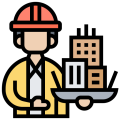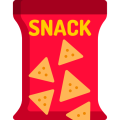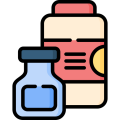Refractory Testing
Creep Test:
Creep testing of materials at high temperatures is a significant field of study at many industry levels.
Accurate high temperature creep data is essential for the proper design and construction of any structural
element operating at elevated temperatures. As such, ways of improving upon conventional creep testing
methods at high temperature are highly sought after.
Test Method: IS: 1528 (P-18)1993
Permanent Linear Change Test:
This test helps in determining the critical linear markings and measurements in green condition, after
drying and after firing. The permanent change in dimensions is quantified as linear change.
Test Method: IS: 1528 (P-6)1974
Pyrometric Cone EquivalentTest:
This test helps in determining the fire-clay variations, mining control, and developing raw material
specifications.
Refractories Under Load Test:
This test helps in determining the deformation behaviour of refractory ceramic products subjected to a
constant load and increasing temperature.
Test Method: ISO 1893
Abrasion Test:
This test helps in determining the relative abrasion resistance of refractory bricks at room temperature.
This test method can be performed for castable refractories.
Air Permeability Test:
This test helps in determining the measurement of air permeability in textile fabrics. This test method
applies to most fabrics including woven fabrics, non-woven fabrics, airbag fabrics, blankets, napped fabrics,
knitted fabrics, layered fabrics, and pile fabrics. The fabrics may be untreated, resin-treated, coated,
heavily sized, or otherwise treated.
Petrographic Analysis by Optical Microscopy:
This test helps in determining the microscopic analysis of materials using thin sections of polished surfaces.
Acid Resistance Test:
Test Method: This test helps in determining the acid resistance capacity of the refractory material.
Test Method: IS: 4860-1968
Thermal Conductivity Test:
Thermal conductivity depends upon the mineralogical and chemical compositions along with the glassy phase
contained in the application and refractory temperature. The conductivity usually changes with the rise in
temperature. In case, where heat transfer is required through brickwork, for example in recuperators,
re-generators, muffles, etc. the refractory should have high conductivity. Low thermal conductivity is
desirable for the conservation of heat by providing adequate insulation.
Test Method: IS: 1528 (P-16)1991
Particle SizeTest:
This test helps in determining the percentile quantity of particles of known diameter within a sample. The
specimen can be passed in two ways. Either through a set of standard sieves in its natural state or if a
certain amount of binding material such as clay is present, then the sample can first be washed over a
small aperture sieve to remove such material.
Test Method: IS: 1528 (P-14) 1974
Water Absorption Test:
The amount of water that refractory can absorb is measured by the water absorption test. The results of water
absorption tests are used for quality assurance.
Test Method: IS 3495 (P-2)1992
Apparent Porosity Test:
Apparent porosity, water absorption, apparent specific gravity, and bulk density are primary properties of
burned refractory brick and shapes. These properties are widely used in the measurement and comparison of
product quality and as part of the criteria for selection and use of refractory products in a variety of
industrial applications.
Test Method: IS: 1528 (P-8)1974
Cold Crushing Strength Test:
This test helps in determining the strength of a brick. It specifies how much load the refractory can bear
in cold conditions. Metallurgy gave birth to this concept of testing CCS of refractory material. This is
because for any refractory brick it is rather; rare that it would fail simply due to load on it in cold
condition and therefore, the determination of cold crushing strength does not appear to be that much
important from this point of view.
Test Method: IS: 1528 (P-4)1974
Bulk Density Test:
A useful property of refractories is bulk density, which defines the material present in a given volume.
An increase in bulk density of a given refractory increases its heat capacity, its volume stability and
resistance to slag penetration.
Test Method: IS: 1528 (P-12)2009
Modulus Of Rupture Test:
The modulus of rupture (MOR) is the maximum surface stress in a bent beam at the instance of failure. One
might expect this to be exactly the same as the strength measured in tension, but it is always larger
because the volume subjected to this maximum stress is small, and the probability of a large flaw lying in
the highly stressed region is small.
Test Method: IS: 1528 (P-5)1993, IS: 1528 (P-15)1991
Dimensional Check:
Refractory materials must maintain dimensional stability under extreme temperatures (including repeated
thermal cycling) and constant corrosion from very hot liquids and gases. The standard for refractory
materials restricts compressive creep for normal working conditions to no more than 0.3 per cent in the
first 50 hours.
Test Method: IS: 1077-1992, IS: 10570-1983
 Admin Register
Admin Register

 Alcohol
Alcohol  Baby Care
Baby Care  Bakery, Cakes & Dairy
Bakery, Cakes & Dairy  Beauty-&-Hygiene
Beauty-&-Hygiene  Beverages
Beverages  Cleaning & Household
Cleaning & Household  Construction Materials
Construction Materials  Foodgrains, Oil & Masala
Foodgrains, Oil & Masala  Medicine
Medicine  Medicine Related Cosmetics
Medicine Related Cosmetics  Non-Veg
Non-Veg  Pesticides
Pesticides  Snacks & Branded Foods
Snacks & Branded Foods  Supplement
Supplement  Veterinary
Veterinary 